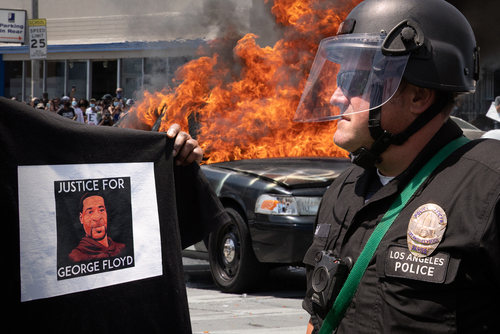
In a startling turn of events, Derek Chauvin, the former police officer convicted in the death of George Floyd, became the victim of a brutal prison assault. The attacker, John Turscak, is no ordinary inmate; his past as an FBI informant adds layers of complexity to this already shocking incident.
On a day that Americans were scouring for Black Friday deals, Chauvin faced a life-threatening situation when Turscak, armed with a makeshift weapon, stabbed him 22 times. The quick intervention of correctional officers prevented what could have been a fatal outcome, saving Chauvin’s life and necessitating immediate medical attention.
Something is Very Off with this Story…
Derek Chauvin was Stabbed 22 Times by a Man Named John Turscak – Who the Media is Saying was a BLM Member and ex-FBI Informant
This reporter claims to have received a phone call from a burner phone from his friend “Smokey”.
Turscak was… pic.twitter.com/FlBHpNZT5D
— UltraMJTruth (@MJTruthUltra) December 2, 2023
The choice of Black Friday for the attack was not random. Turscak’s confession revealed a symbolic nod to the Black Lives Matter movement, which had been thrust into the national spotlight following Floyd’s death. His reference to the “Black Hand” symbol further connected the assault to gang influences, specifically the Mexican Mafia.
Federal authorities charged Turscak with multiple counts, including attempted murder and assault with intent to commit murder. These charges reflect the severity of the attack and the potential premeditation involved.
Derek Chauvin was stabbed 22 times by a former FBI informant and Mexican Mafia member, who says he did it in solidarity with BLM. His race is listed as white in the Federal Bureau of Prisons. The journalist who spoke with Chauvin and produced "The Fall of Minneapolis", Liz… pic.twitter.com/FshZ6NhRRt
— Jesse Watters (@JesseBWatters) December 2, 2023
The revelation that Turscak was once an FBI informant complicates the narrative. His history with the bureau dates back to the late 1990s when he led a faction of the Mexican Mafia in Los Angeles and was known by the moniker “Stranger.” His cooperation with the FBI, beginning in 1997, was marked by providing crucial intelligence on gang operations.
Despite his role as an informant, Turscak’s criminal activities persisted. He was implicated in drug dealing, extortion, and orchestrating assaults while under the FBI’s watch. His actions contributed to the indictment of over 40 alleged Mexican Mafia members, yet they also strained his relationship with the agency.
Court documents paint a picture of a man deeply entrenched in gang warfare, plotting attacks against rivals and even attempting to assassinate a gang leader. The dangers of his lifestyle were underscored by his own targeting within these violent conflicts.
In a plea deal struck in 2001, Turscak admitted to racketeering and conspiracy to murder a gang rival. Although facing a possible life sentence, his ties to the FBI resulted in a reduced 30-year term. At his sentencing, Turscak defended his criminal behavior as a survival mechanism, a sentiment he claimed was echoed by the FBI agents who advised him to do “whatever was necessary.”
This incident raises questions about the rehabilitation and monitoring of former informants within the prison system. It also underscores the ongoing challenges law enforcement faces when dealing with informants who straddle the line between aiding investigations and perpetuating criminal activity. As the investigation into the attack continues, the public is left to grapple with the complexities of justice, redemption, and the thin line between right and wrong.












